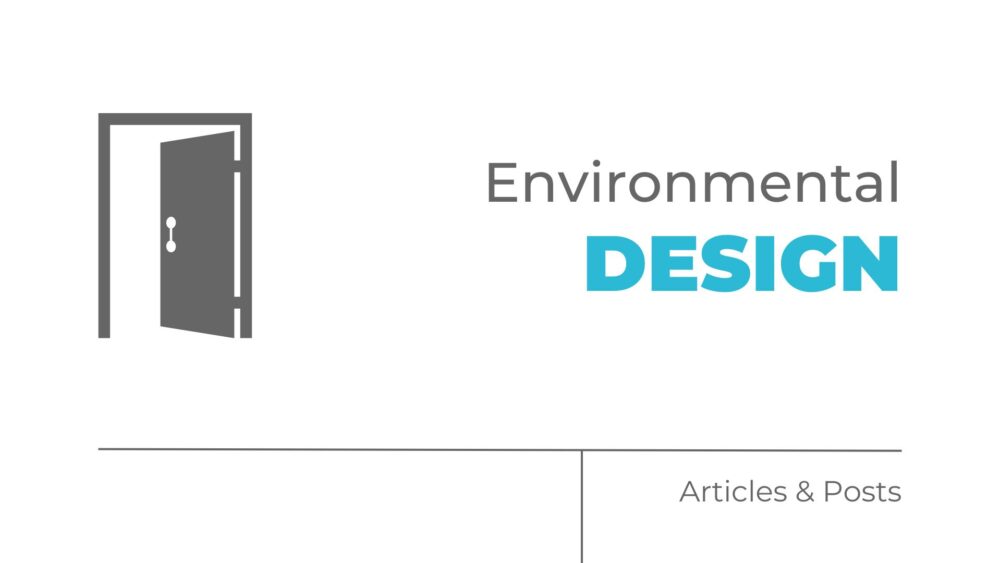In the bustling world of marketing, the visual appeal of your brand is paramount.
(We love branding at MOCK, the Agency!)
Every color, shape, and line communicates a message to your audience, shaping their perceptions and driving their actions.
As your team seeks to elevate your brand presence, you may find yourself delving into the realm of design, considering various disciplines to bring your vision to life.
One such intriguing field is environmental design.
Environmental Design is a powerful force in graphic design that literally shapes the physical spaces we inhabit.
What does an environmental designer do?
At the heart of environmental design lies the art of creating immersive experiences that seamlessly blend with their surroundings, capturing the essence of a brand and captivating its audience.
While UX design is for digital, environmental design is for in-person experiences.
Imagine strolling through a bustling city square, greeted by vibrant murals that tell the story of a community’s history.
Or stepping into a retail store where every corner whispers the brand’s narrative through carefully curated displays and spatial arrangements.
This is the work of an environmental designer.
Environmental designers possess a keen understanding of human behavior and spatial dynamics.
They harness their expertise in graphic design, architecture, and psychology to craft environments that evoke specific emotions and foster meaningful interactions.
From corporate offices to public parks, their creations leave a lasting impression, shaping the way people perceive and engage with their surroundings.
What are some examples of environmental graphic design?
Environmental graphic design (EGD) encompasses a diverse array of projects, each bearing the imprint of its designer’s creativity and ingenuity.
Picture a bustling airport terminal, where wayfinding signs guide travelers with effortless elegance, seamlessly blending form and function.
These signs not only provide essential information but also serve as landmarks, imbuing the space with a sense of identity and cohesion.
In retail settings, environmental graphic design takes center stage, transforming brick-and-mortar stores into immersive brand experiences.
From window displays that stop pedestrians in their tracks to interior graphics that invite exploration, every element is meticulously crafted to reinforce the brand’s story and values.
Think of flagship stores that transcend mere shopping destinations.
Where it’s not just about the products – the places themselves have become destinations in their own right.
Like IKEA.
In places like this, customers are drawn in by the promise of a unique and unforgettable journey.
What is included in environmental design?
Environmental design is a multidisciplinary field that encompasses a wide range of elements, each playing a crucial role in shaping the overall experience.
From signage and wayfinding systems to interior graphics and experiential installations, every detail is thoughtfully considered to create a cohesive and compelling environment.
In addition to visual elements, environmental design also encompasses aspects such as lighting, sound, and spatial layout.
By orchestrating these elements in harmony, designers can create immersive environments that engage the senses and evoke powerful emotions.
Imagine walking into a museum exhibit where carefully curated lighting sets the stage for a transformative journey through art and history.
Or stepping into a corporate headquarters where the layout of the space fosters collaboration and creativity among employees.
Is environmental design an architecture?
While environmental design shares certain principles with architecture, it is distinct in its focus on creating immersive experiences within a given space.
While architects are primarily concerned with the physical structure and functionality of buildings, environmental designers are tasked with enhancing the user experience through thoughtful integration of graphic elements, signage, and spatial arrangements.
In essence, environmental design complements architecture by adding layers of meaning and storytelling to the built environment.
Is environmental design the same as interior design?
While environmental design and interior design share some similarities, they differ in scope and focus.
Interior design primarily deals with the aesthetic and functional aspects of interior spaces, such as selecting furniture, fabrics, and color schemes to create a cohesive and inviting atmosphere.
Environmental design, on the other hand, takes a broader approach, encompassing not only the visual elements of a space but also its overall sensory experience.
Environmental designers work closely with architects and interior designers to ensure that every aspect of a space contributes to a unified and impactful brand experience.
At the End of the Day
Environmental design offers companies a powerful tool for creating immersive brand experiences that resonate with their audience on a deeper level.
By harnessing the principles of graphic design, architecture, and psychology, environmental designers can transform ordinary spaces into extraordinary environments that leave a lasting impression.
As you explore the myriad possibilities of design, consider the transformative potential of environmental design in shaping the narrative of your brand and captivating your audience’s imagination.


Comments are closed.